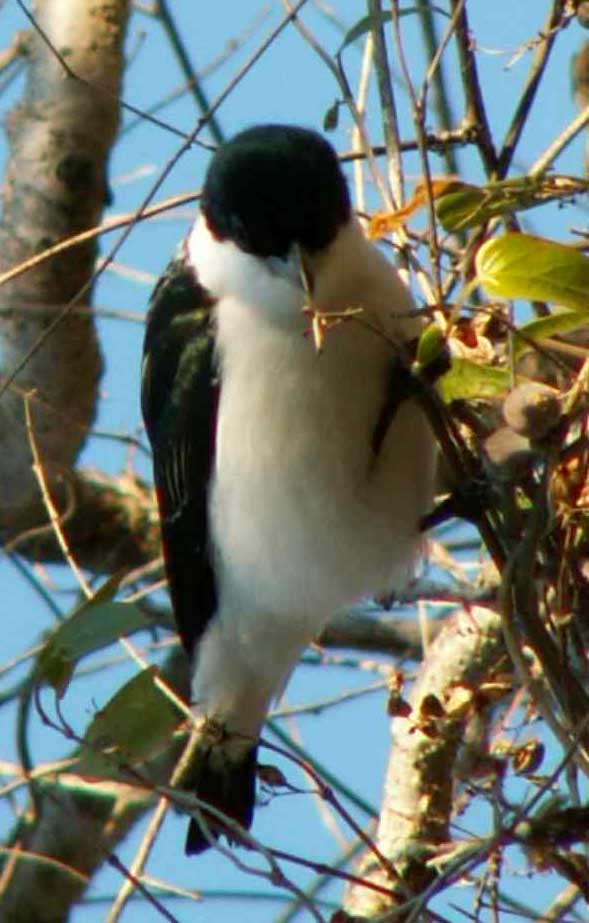
Leptopterus chabert (*)
Superregnum: Eukaryota
Regnum: Animalia
Subregnum: Eumetazoa
Cladus: Bilateria
Cladus: Nephrozoa
Superphylum: Deuterostomia
Phylum: Chordata
Subphylum: Vertebrata
Infraphylum: Gnathostomata
Superclassis: Tetrapoda
Cladus: Reptiliomorpha
Cladus: Amniota
Classis: Reptilia
Cladus: Eureptilia
Cladus: Romeriida
Subclassis: Diapsida
Cladus: Sauria
Infraclassis: Archosauromorpha
Cladus: Crurotarsi
Divisio: Archosauria
Subsectio: Ornithodira
Subtaxon: Dinosauromorpha
Cladus: Dinosauria
Ordo: Saurischia
Cladus: Eusaurischia
Cladus: Theropoda
Cladus: Neotheropoda
Cladus: Averostra
Cladus: Tetanurae
Cladus: Avetheropoda
Cladus: Coelurosauria
Cladus: Maniraptoromorpha
Cladus: Maniraptoriformes
Cladus: Maniraptora
Cladus: Pennaraptora
Cladus: Eumaniraptora
Cladus: Avialae
Infraclassis: Aves
Ordo: Passeriformes
Subordo: Passeri
Parvordo: Corvida
Superfamilia: Corvoidea
Familia: Vangidae
Genus: Leptopterus
Species: Leptopterus chabert
Subspecies: L. c. chabert - L. c. schistocercus
Name
Leptopterus chabert (Statius Müller, 1776)
References
Des Ritters C. von Linne...vollstandiges Natursystem. Supplement p. 72
Vernacular names
English: Chabert's Vanga
español: Vanga chabert
فارسی: وانگای شابر
français: Artamie de Chabert
magyar: Szarkavanga
italiano: Vanga di Chabert
Nederlands: Brilvanga
svenska: Glasögonvanga
The chabert vanga (Leptopterus chabert), also erroneously called "Chabert's vanga",[2] is a species of bird in the family Vangidae. It is monotypic within the genus Leptopterus.[3] The chabert vanga is the smallest bird in the vanga family when compared to the white-headed vanga and the blue vanga. Their biometrics are typically 14 centimeters in length and their weight ranges from 17 to 26.5 grams.[4]
Habitat
The chabert vanga is endemic to Madagascar. Its natural habitats are subtropical or tropical dry forest, subtropical or tropical moist lowland forest, and subtropical or tropical moist montane forest.[1] They tend to reside on sea level and up to 1000m. Very occasionally they are found higher than 1000m above sea level.[5]
Vocalizations
The chabert vanga's name comes from a rendition of its call.[3] Their calls tend to repeat every two to three seconds making the sound “teedee” or a “tse tse tse” when trying to communicate.[5]
Diet
They feed on insects such as; beetles, cockroaches, and worms. Also, they have been found to eat small vertebrates such as chameleons and some small berries.[5]
Description
The cabaret vanga only possess two colors, black and white. Their head and wings are a dark black. However, due to the sun, this black can often be seen as having a shiny blue tint to it. Their underparts are white like their chin and belly. The color of their tails differ from where they originate. If they are located in the southwest, the tail of the chabert vanga has a white patch at the base of the tail.[6] If they are from anywhere else in the world, the whole entire tail of the chabert vanga is known to be black. The bill is a light blue color and their eyes also resemble a turquoise or cobalt blue. The juvenile of the cabaret vanga resembles the adult however, it lacks the blue eyes. The juveniles tend to look a shade paler due to the white streaks and white fingers on their back and wing feathers. The white streaks tend to fade as they grow older. There is little physical difference between the male and female chabert vanga.[5]
Subspecies
Leptopterus chabert chaber is found in west, north, and eastern Madagascar. Leptopterus chabert schistocercus is found in southwest Madagascar.[4]
Status
Cabert vangas are not currently globally threatened. They are fairly common throughout their range in the madagascar and surrounding areas. They are less common in more humid areas and dense forests. The chabert vanga is most commonly spotted at the edge of forests and dense tree populations. [5] They are constantly moving and migrating. They are typically found in flocks rather than individually seen.[6]
References
BirdLife International (2016). "Leptopterus chabert". IUCN Red List of Threatened Species. 2016: e.T22708046A94147282. doi:10.2305/IUCN.UK.2016-3.RLTS.T22708046A94147282.en. Retrieved 14 November 2021.
"English Name Updates". IOC World Bird List. Archived from the original on 2011-11-07. Retrieved 1 November 2011.
"ITIS Report: Leptoterus". Integrated Taxonomic Information System. Retrieved 8 August 2014.
Struik, Publishers (July 18, 2011). "Chabert's Vanga Leptopterus chabert". Chabert's Vanga. Archived from the original on 2018-02-08.
Yamagishi, Satoshi; Nakamura, Masahiko (2020-03-04). "Chabert Vanga (Leptopterus chabert)". Birds of the World.
"Chabert Vanga - eBird". ebird.org. Retrieved 2021-10-19.
Retrieved from "http://en.wikipedia.org/"
All text is available under the terms of the GNU Free Documentation License

